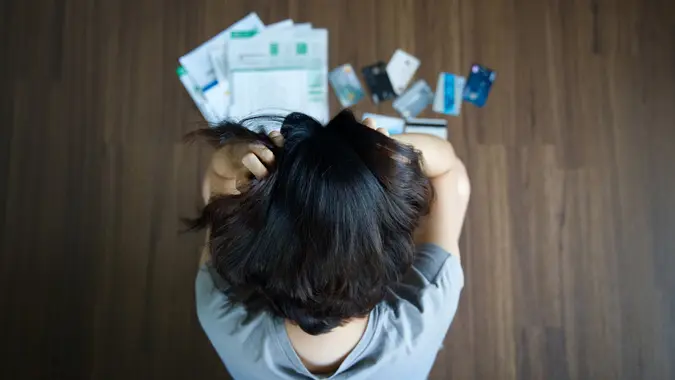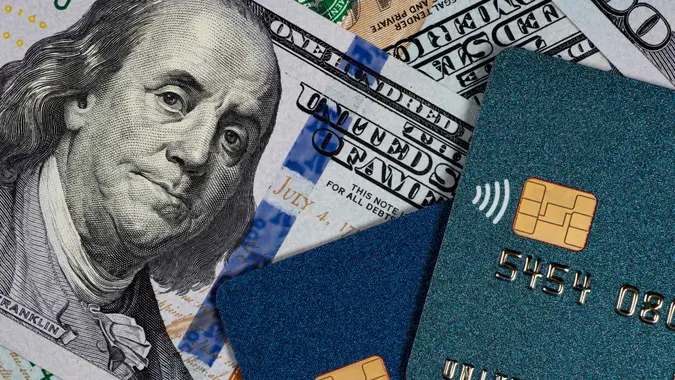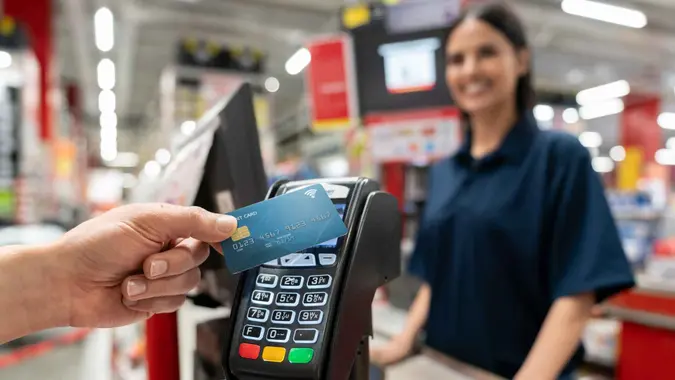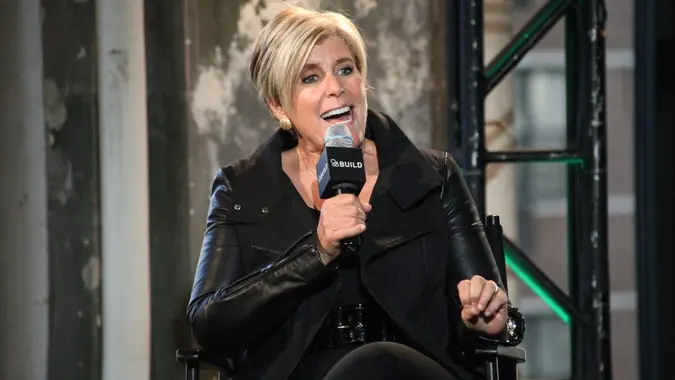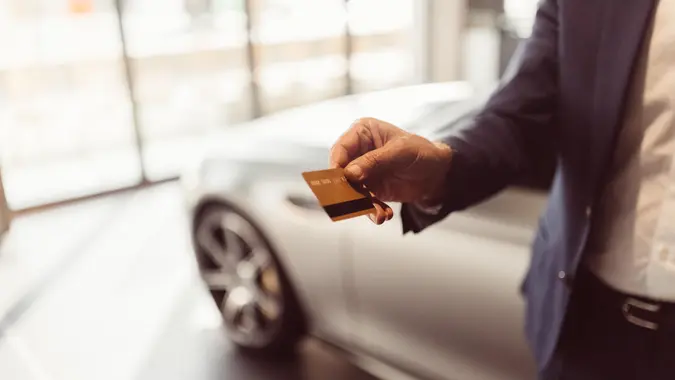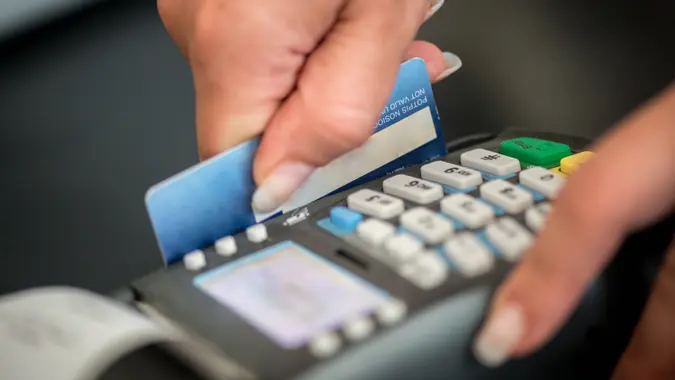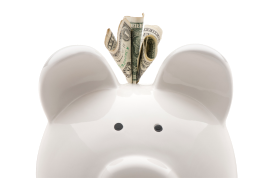10 Ways To Protect Yourself From Credit Card Fraud at Gas Stations
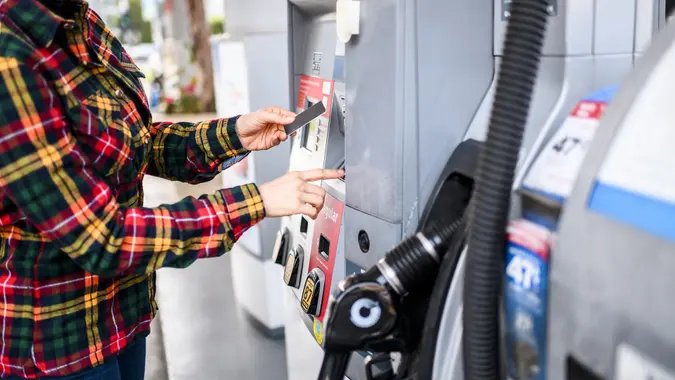
Commitment to Our Readers
GOBankingRates' editorial team is committed to bringing you unbiased reviews and information. We use data-driven methodologies to evaluate financial products and services - our reviews and ratings are not influenced by advertisers. You can read more about our editorial guidelines and our products and services review methodology.

20 Years
Helping You Live Richer

Reviewed
by Experts

Trusted by
Millions of Readers
Paying with a credit card at the gas station comes with certain risks in today’s world. Gas pumps have become a prime target for thieves seeking to steal credit card information through high-tech skimming devices.
However, by understanding the latest techniques fraudsters use and taking appropriate security precautions, diligent customers can avoid becoming victims of gas station credit card theft.
Carefully Inspect Card Readers for Tampering or Skimming Devices
One of the most common schemes is when criminals install a skimming device directly over the real credit card slot at the pump. These skimmers capture and store your card data when you insert or swipe your card.
To spot potential skimmers, check that the credit card slot does not appear different or more bulky compared to the other pumps around it. Sometimes the keypad will look damaged or rigged.
Additionally, most skimming devices attach via double-sided tape for quick installation and removal by criminals. Before using your card, first gently wiggle or tug on the slot reader to verify it is securely fastened and not loose. Loose or detached readers likely have skimmers attached.
If anything seems suspicious, report it immediately to the gas station attendant and do not insert your card. Notify local police as well about potential credit card skimmers in the area.
Verify Tamper-Evident Security Stickers Are Intact
In some cases, criminals will break directly into the gas pumps to implant skimming devices internally where customers cannot see them.
To combat this, many stations place tamper-proof security stickers across cabinet doors and checkpoints. Always check that these stickers are completely intact, with no tearing or peeling that indicates someone may have improperly accessed the machine. Some decals turn black or red when removed.
If you see the word “VOID” displayed, that means the seal was broken. In those cases, it is best not to use that pump. Choose a different lane and notify the station workers or authorities. Never assume pumps close to the attendant are safer. Always check for signs of tampering no matter which pump you select. Damaged security stickers are the No. 1 sign of potential compromise.
Take Steps To Block Hidden Cameras From Viewing Your PIN Entry
In conjunction with card skimmers, thieves also will sometimes hide tiny pinhole cameras above the keypad to record customers entering PIN numbers. Criminals can then take stolen debit card data and drain bank account funds via ATM withdrawals.
To combat pinhole cameras, use your other hand to cup and conceal the keypad as you type in your PIN. Also, relying on credit cards rather than debit cards reduces risks, since credit cards do not require PINs. When possible at gas stations, stick to credit over debit to keep your checking account protected.
Minimize Your Risk of RFID Card Scanning
Another advanced technological threat is the RFID scanner. If your credit or debit card contains an RFID smart chip, it could be vulnerable to electronic pickpocketing devices. Handheld RFID scanners allow thieves to inconspicuously scan your card data from two to three inches away without ever touching your wallet.
To prevent RFID credit card theft, slide your cards into a protective sleeve or wrap them in foil when not in use. This blocks the scanning signal. Also be cautious of anyone lingering too closely around you while at the pump. Keep your guard up and protect your physical card itself from scanning.
Select Pumps Closest to the Attendant When Possible
Whenever you have a choice, pick the pump positioned closest to the main cashier or attendant station. Skimmers and pinhole cameras are less likely to be installed directly adjacent to the employee area where installers could more easily be spotted.
However, this does not guarantee safety, so remain vigilant on inspection. But pumps nearer to the attendant do present less desirability for fraudsters. Just be sure to check thoroughly for tampering regardless of where you fuel up.
Trust Your Instincts — Consider Paying Cash If Something Seems Off
If anything strikes you as odd or suspicious at a gas station, it’s best to go with your gut instinct and avoid using a credit card. If a pump looks abnormal or you witness suspicious activity, consider going inside and prepaying the exact amount of gas you intend to pump. This eliminates the risks associated with card skimmers.
Of course, cash lacks fraud protection or rewards. But when in doubt, cash protects your accounts and identity. You can always visit another station down the road to earn your credit card points.
Monitor Statements Routinely and Set Transaction Alerts
It’s always wise to periodically review your credit card and bank statements with vigilance even if you do take precautions. If your card data is compromised by a skimmer, fraudulent charges will show up after the fact. Immediately call your bank or credit card company if you spot any unfamiliar charges.
Also consider setting up transaction alerts to be notified any time your card is used for over a certain purchase amount threshold. This allows you to monitor activity in real time and catch fraud quickly before escalation.
While potential risks exist at the gas pump, following these tips will help you avoid credit card theft and feel confident fueling up safely. Don’t let fear of skimmers prevent you from getting your fill-up and enjoying any associated credit card rewards. Just stay alert and take the right precautions to outsmart scammers.
Set Card Use Alerts To Detect Fraud
Because skimmed card data may be used for online shopping, where merchants don’t view the physical card, you should set up alerts for transactions over $100. Routinely monitoring statements is also wise so you can catch unauthorized charges quickly, especially if you frequent crowded areas like airports where skimming is more likely. Proactive monitoring gives you the best shot at stopping fraud in its tracks.
Use Gas Station Gift Cards for Added Protection
If you visit certain gas stations frequently, consider purchasing prepaid gift cards to use instead of your credit or debit card. Gift cards do not contain any of your personal information.
Because the cards have a set value, your potential loss would be contained if a scammer somehow managed to steal the gift card numbers. Gas gift cards offer an extra layer of protection while keeping your financial accounts shielded.
Pay Through Gas Station Apps
Another secure payment method is using a gas company mobile app like Shell or ExxonMobile. These apps allow you to activate the pump and pay directly from your smartphone. This avoids inserting or swiping your card at the pump. Mobile apps offer a contactless payment solution to enhance security and convenience while fueling up.
What To Do If You Are Skimmed
Check statements routinely for unfamiliar charges. Report unauthorized activity to your credit card company or bank immediately to block the compromised card and account. Consider fraud alerts on accounts to monitor suspicious transactions. With vigilance and reporting, financial institutions can catch fraud swiftly to minimize losses.
While risks exist, simple awareness and precautions thwart most gas credit card scams. Follow these tips for safely paying at the pump and keeping your accounts protected. Stay alert, but don’t let fear over hype deter you from reaping credit card rewards on gas purchases.
Jennifer Calonia contributed to the reporting for this article.
More From GOBankingRates
- 6 Expensive Costco Items That Are Definitely Worth the Cost
- How Much Does the Average Middle-Class Person Have in Savings?
- 5 Reasons You Should Consider an Annuity For Your Retirement Savings
- 10 New Cars to Avoid Buying in 2024
Editorial Note: This content is not provided by Chase. Any opinions, analyses, reviews, ratings or recommendations expressed in this article are those of the author alone and have not been reviewed, approved or otherwise endorsed by Chase.





